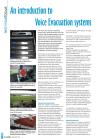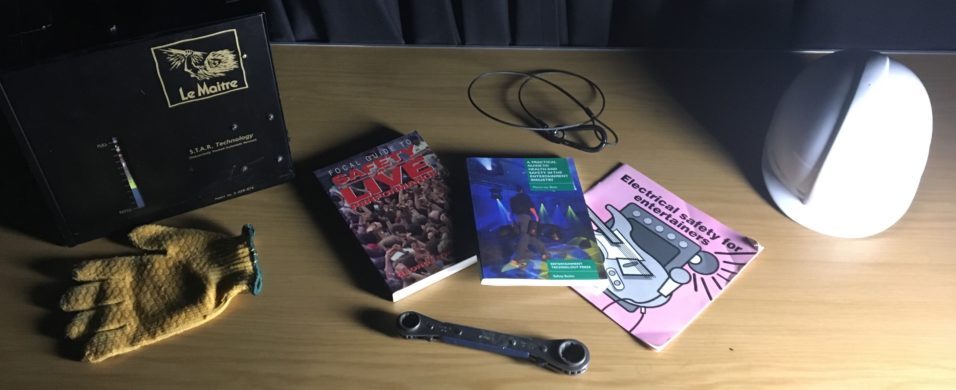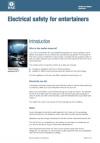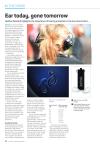The aim of this page is to list some of the Health and Safety regulations that exist to protect everyone working in live events. This is initially focussed on the UK, but will cover more territories in time.
2009 Health and Safety Management in the Live Music and Events Industry
Health and Safety Management in the Live Music and Events Industry
Buy at
Amazon UK
Amazon US 2000 A Practical Guide to Health and Safety in the Entertainment Industry
A Practical Guide to Health and Safety in the Entertainment Industry
Buy at
Amazon UK
Amazon US
Safe System of Work
Every activity required to put on a show of any kind should have a series of procedures which are documented, regularly revised and reviewed, and followed by all involved in the activity. These documents should be available to anyone involved in the activity to review BEFORE the activity takes place.
Risk Assessment
What is a Risk Assessment?
A Risk Assessment is a formal record of hazards in the workplace, identifying the risks they pose, defining the seriousness and likelihood of the risks, and explaining the control methods to reduce the risks to acceptable levels.
How do I fill out a Risk Assessment?
The Health & Safety Executive (UK) has a set of sample risk assessments for various businesses. [HSE Website]
Can I download a sample risk assessment for a theatre?
We’re working on a series of sample risk assessments, and these will be available to download in the coming months.
Access Equipment
The Work at Height Regulations 2005 have very clear guidance on using equipment to access high levels.
See the Health & Safety Executive (UK) guidance.
Electrical Safety
PAT Testing (Electricity at Work Act, 1989)
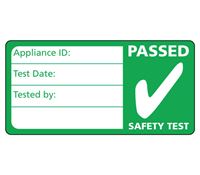
PAT Test Label (LabelsOnline)
All portable electrical equipment must be periodically tested to ensure it is safe to use, and the results should be recorded for future reference.
A large percentage of faults can be easily found by carrying out a visual check.
Visual Check
- Unplug the item before carrying out any check
- Is the flex correctly secured in the plug?
- Is the cable free from any breaks, cracks, temporary repairs or other damage? (any electrical tape on the cable should be removed, and if a problem is found, the equipment should be taken out of service).
- Can any of the inner cores of the cable (usually coloured brown, blue and green/yellow) be seen through the outer protective cable sheath?
- Is the case fully intact and unbroken?
- Are there any marks on the equipment or plug which may indicate overheating?
- Does the equipment work as intended?
If any of the above checks fail, the equipment must be taken out of service and repaired by a competent person.
Further information about electrical tests and checks can be found on the HSE website.
External Links
MORE INFORMATION COMING SOON
Lighting Rigging
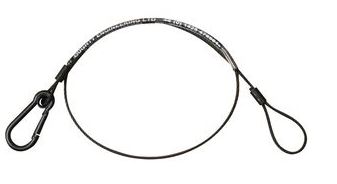
5kg Safety Bond (Doughty Engineering)
The need for secondary safety supports is covered under the Work at Height Regulations 2005.
From the HSE website:
The Work at Height Regulations 2005 require employers to take steps to ensure that people can’t be hurt by falling objects. This involves assessing the risks and taking action to control them. If the theatre’s risk assessment suggests this is best managed with steel wire rather than chain then they have a duty to implement that control. As an employee, you have legal duties to co-operate with your employer to ensure they can comply with their duties.
Professional bodies such as the ABTT in the UK, and standard professional practice, require safety wires to be used on all suspended equipment. In the UK, safety chains were formerly used, but these should not now be used as the chain cannot be certified to carry a particular load. Safety wires (made for the purpose) are properly rated, and stamped with the rating. A range of wires are available, from stage equipment suppliers, rated to carry loads from 5kg (for accessories such as barndoors) to 100kg (for larger lanterns and moving lights).
Audience Safety Concerns
Strobe Lights / Flashing Lights
Certain combinations of flashing lights can trigger seizures for anyone with photo-sensitive epilepsy. Warning signs should always be used when lighting effects are being used that could trigger a seizure. Be as specific as possible so that the audience knows what to expect. Don’t forget that actors, crew-members, orchestra members can also be triggered. Here are some examples:
- Fast Strobing Lights are used in this performance
- Camera Flash lighting effects are used in this performance
- Multiple Strobes and Flashing Lights are used in this performance
- An explosion lighting effect is used in this performance
Ensure the signs can be seen by everyone entering the venue.
Fire Safety
All items used on stage should be adequately fire-resistant. This includes scenic drapes and costumes. Where fire risks are increased (e.g. near pyrotechnic devices, hot lighting equipment) then extra precautions should be taken.
How to reduce fire risk:
- Limit (or ban) the use of naked flames
- No electrical heaters in dressing rooms
- Turn off all electrical equipment after use
- Don’t run tumble driers or other appliances overnight or when unattended
- Ensure hot lanterns are away from drapes or scenery
- Do not turn on lanterns if they are within the manufacturers recommended distance of anything as the light beam is hot and can burn items.
- Use fire retardant materials for all stage drapes and costumes.
Theatre Fires:
See also Asbestos in the Theatre
Hearing Protection
The UK Control of Noise At Work Regulations give clear instructions to employers to protect the hearing of their employees.
Voice Evacuation Systems
Clearly audible, instructive and authoriatative PA systems for use in emergencies.
Testing
All systems connected with safety must be regularly maintained and tested. The frequency of testing will be set by local regulations.
Visual checks should be carried out every time an item (e.g. a ladder) is used. If there are signs of damage, it should be referred to the responsible person to be tested and if necessary replaced. No equipment that raises concern during a visual check should be used if a different item is available.
Safety Related Links
External Links
Discussion Forums |
| Podcast: Production Meetings Essential listening |
Health & Safety |
| BAPAM British Association for Performing Arts Medicine [UK] |
| ESTA Fog / Smoke [USA] |
| NIOSH Pocket Guide to Chemical Hazards [USA] |
| Online Sign Free Printable Safety Sign Maker |
| Rosco: Flame Retarding Scenery |
| RU Safe? information and guidance about safety in small venues [UK] |
| The Purple Book - The Purple Guide to Health, Safety and Welfare at Music and Other Events [UK] |
| The Yellow Book - ABTT Technical Standards for Places of Entertainment Safety standards and guidelines for venues. [UK] |
| Theatre Safety Blog |
Resources |
| Allan Chapman & James Insurance Public Liability Insurance etc. [UK] |
| Guide on Running Events Safely UK Health & Safety Exectuive [UK] |
| La Playa UK Public Liability Insurance etc. [UK / USA] |
| Wrightsure Insurance Public Liability Insurance [UK] |
Suppliers |
| Actor Cigarette Safe Smoking Prop |
Unions / Associations |
| AAPTLE Alliance of Associations & Professionals in Theatre and Live Events [UK] |
| ABTT (Association of British Theatre Technicians) Training, Advice, Membership [London, UK] |
| IATSE International Alliance of Theatrical Stage Employees [USA] |
| LPA Live Performance Australia |
| PLASA UK Professional Lighting & Sound Association [UK] |
Glossary Entries
ASTM
American Society for the Testing of Materials. Founded in 1898 and based in Pennsylvania. The ASTM arose out of efforts by Charles Dudley to standardise specifications for materials used across the construction of the Pennsylvania Railroad.
ASTM Website
BASSC
Short for British Academy of Stage and Screen Combat.
(From their website: The British Academy of Stage & Screen Combat was founded in 1993 with the aim of improving the standards of safety, quality and training of stage combat and promoting a unified code of practice for the training, teaching and assessing of stage combat within the United Kingdom.)
BOOT COVER
Disposable cover for shoes and boots when going into newly refurbished areas to prevent dirt from other environments being tracked in. Also used to prevent contamination in clinical areas.
COMING IN
Warning used when flying scenery or lighting bars (electrics).
e.g. "First Electric Coming In", "Heads on Stage - LX3 coming in!" etc.
See GOING OUT, FLYING.
CONSTRUCTION (DESIGN AND MANAGEMENT) REGULATIONS (CDM)
UK Regulations introduced in 2015 covering any construction project. Many live event construction projects (e.g. building set, raised stages etc) are covered by the regulations.
UK Health and Safety Executive website
CONTINGENCY
An alternative plan of action if a piece of technology fails to operate. Large-scale productions have to continue wherever possible to avoid having to give the audience refunds. So if a small piece of the set fails to work or gets stuck (particularly automated scenery) the cast and crew will have rehearsed an alternative choreography to work around it while the crew repair it. For example in The Lord of the Rings The Musical in London, when the revolving stage with multiple lifts had a safety sensor triggered, the automation went into 'E-Stop' mode, a thunderclap sound effect was triggered, the stage lifts went to a flat floor (once it had been found safe to do so) and the actors for the next scene were rushed into new positions, while the actors on stage immediately adopted a new choreography.
It's vital that contingencies are worked out in advance so that as soon as something goes wrong, the show can continue, and the audience will hopefully be unaware.
COSHH
(UK Health and Safety) Acronym for Control of Substances Hazardous to Health Regulations 2002. Requires employers to prevent or reduce their workers' exposure to substances that are hazardous to their health.
As well as dangerous chemicals and solvents, COSHH also covers ANY substance that is hazardous, including dust particles in a set-building environment.
HSE COSHH website
DRENCHER
System of pipes arranged at the top of a safety curtain (aka Iron) to drench it with water in the event of fire. The water prevents it buckling as it descends.
FALL ARREST
Fall Arrest systems are used by rigging crews who work at high level, and is designed to catch a fall and prevent the person from being hurt. The preferred method of protecting crews working at height is Fall Restraint, which prevents the fall from taking place by not allowing the person to reach the edge of the roof / stage.
The systems consist of a harness and rigging to hold the person safely. There must also be a rescue plan in place so that the person can be rescued and taken to medical care as soon as possible after falling.
FIRE MARSHAL
(US) A representative of the local fire department who should be consulted about any questions you have about using fire-retardant materials on stage, anything involving pyrotechnics, and some smoke / haze effects, if you have a smoke detection system. You may also need to consult them about changing seating layouts in a flexible venue, and any unusual use of your venue(s).
FIRE TRIANGLE
There are 3 requirements for a fire to take place, which can be depicted as a triangle.
1) HEAT
2) FUEL
3) OXYGEN
If you take one of the requirements away, the fire will go out.
A water fire extinguisher uses water to COOL the fire, removing the heat.
A carbon dioxide fire extinguisher uses the gas to displace the OXYGEN.
GOING OUT
Warning that a flying bar is about to be lifted.
e.g. "LX3 Going Out".
See also COMING IN, FLYING
HEALTH AND SAFETY
(Abbreviated to H&S) UK term to cover a range of legislation and guidance on how to work safely, and to reduce accidents or incidents.
The legal component is the Health and Safety at Work Act (1974), but there are a number of regulations which relate to safe working.
See COSHH, SAFE SYSTEM OF WORK, LOLER, PPE, PUWER, RIDDOR.
Safety in Live Entertainment on Theatrecrafts.com
ICOPER
Acronym for International Code of Practice for Entertainment Rigging.
A new standard, published in 2017.
Download ICOPER at PLASA
LDR
1) Light-Dependent Resistor. Electronic component used in a circuit to detect the presence (or absence) of light. Used in theme park attractions to detect a passing ride vehicle or in safety / security systems to detect movement past a particular point.
2) Italian lighting manufacturer, founded in 1997.
LDR at Backstage Heritage Collection
LOLER
Abbreviation for Lifting Operations and Lifting Equipment Regulations 1998 (UK Health & Safety Executive).
HSE LOLER page
MANUAL HANDLING
(UK Health & Safety) One of the areas of risk at work which can result in physical damage, through incorrect lifting technique, trying to lift inappropriate weight, or sprains/strains resulting from pressure on the body.
Anyone who moves large or heavy objects as part of their work should carry out a manual handling risk assessment to ensure they are not putting themselves at risk. The amount that an average person can safely lift depends on their position relative to the load, how extended their arms are, if they need to twist their body during the process, and if they have to lift an excessive distance.
Mechanical assistance (such as the use of small wheeled dolly platforms, trolleys, pallet trucks, sack trucks etc) can make handling of some loads easier.
Manual handling should not be carried out alone, wherever possible.
METHOD STATEMENT
Part of the safety information produced by a theatre company to state in detail how they will go about the process of getting the show on while compllying with all relevant safety legislation and best practice for the industry.
Combined with a Risk Assessment, the Method Statement is known as RAMS (Risk Assessment & Method Statement).
See also RISK ASSESSMENT, CDM (UK).
MSDS
Material Safety Data Sheet. Form available from manufacturers of, for example, smoke fluids. Lists any hazardous ingredients and other safety-related data about the product.
OSHA
(USA) Occupational Safety and Health Administration.
Set up by Congress following the Occupational Safety and Health Act in 1970 'to assure safe and healthful working conditions for working men and women by setting and enforcing standards and by providing training, outreach, education and assistance.'
Equivalent to the Health & Safety Executive in the UK.
OSHA Website
PAT TEST
Short for Portable Appliance Test. Requirement under the UK Electricity At Work Regulations (1989) to test and inspect all portable electrical equipment. This includes stage lighting equipment (lanterns, cables, portable dimmer packs etc.).
PPE
(UK - Health & Safety) Abbreviation of Personal Protective Equipment. The equipment that's needed depends on the task and risk assessment but could include: steel toe-capped boots / shoes, protective headgear, gloves etc.
PUWER
Abbreviation for Provision and Use of Work Equipment Regulations 1998 (UK Health & Safety Executive)
HSE PUWER page
RAMS
Acronym from Risk Assessment & Method Statement. RAMS is the paperwork that you should provide when undertaking any activity that requires it.
See also RISK ASSESSMENT, METHOD STATEMENT, CDM.
RISK ASSESSMENT
A Risk Assessment is a document listing the risks and hazards involved in a particular activity, highlighting what controls are in place to reduce the risk to an acceptable (safe) level.
See also METHOD STATEMENT, RAMS, CDM,
S.W.L.
Safe Working Load. The weight load that lifting equipment is expected (and designed) to be able to support safely.
The term has now superseded by WLL (Working Load Limit).
SAFE SYSTEM OF WORK
UK Health and Safety terminology. Can be defined as 'the integration of people, articles and substances in a suitable environment and workplace to produce and maintain an acceptable standard of safety. In this system, due consideration should be given to foreseeable emergencies and the provision of adequate facilities'
Submitted by Chris Higgs
SAFETY BOND
 Chain or wire fixed around lantern and lighting bar or boom to prevent danger in the event of failure of the primary support (eg Hook Clamp). A requirement of most licensing authorities in the UK.
Chain or wire fixed around lantern and lighting bar or boom to prevent danger in the event of failure of the primary support (eg Hook Clamp). A requirement of most licensing authorities in the UK.
As a standard safety chain does not have a rated loading, the current recommendation in the UK is to use an approved (and rated) safety wire (also known as a safety bond or safety cable) as a secondary suspension.
Although hook clamps (in the UK) that support lanterns do not fail, they are subject to a number of human failings including not doing the clamp up sufficiently or not tightening the bolt at the base of the hook clamp that connects to the lantern. However, the highest risk is due to a flown lantern being struck by a piece of scenery or another lantern as it flies past.
SAFETY CURTAIN
 A fireproof "curtain" that can be dropped downstage of the house tabs in a proscenium theatre to separate the audience from the stage in the event of fire.
A fireproof "curtain" that can be dropped downstage of the house tabs in a proscenium theatre to separate the audience from the stage in the event of fire.
A Safety Curtain is required by most UK licensing authorities for theatres of traditional design. The regulations also require that it is raised and lowered at least once in view of each audience (usually during the interval). Usually made from sheet metal and electrically operated, these curtains were originally of iron construction faced with asbestos and lowered by gravity using a hydraulic damping system. Colloquially known as the "iron".
Some Safety Curtains are painted - the iron at the Theatre Royal Drury Lane has a beautiful design with the text "For Thine Especial Safety".
The musical Billy Elliot uses a false iron as a scenic device with a pair of doors in it, which would not be permitted for a real iron.
The line on the stage where the fire curtain drops, usually a short distance from the downstage edge of the stage, is known as the FIRE CURTAIN LINE and cannot be obstructed by any fixed scenery.
The first Safety Curtain is believed to date from 1794 at the Theatre Royal Drury Lane, when a (literal) iron curtain complete with water tanks at roof level were installed at the insistence of Richard Brinsley Sheridan, the theatre manager at the time. His architect / builder was Henry Holland. Unfortunately, the curtain failed to operate when a fire occurred in 1809, as the water tanks had emptied, and the iron had rusted.
Also known as FIRE CURTAIN, IRON or ASBESTOS. See also DRENCHER.
More about Safety Curtains
SAFETY EDGE
A safety sensor on the edge of a piece of automated scenery (usually a moving platform) that the automation system uses to detect something or someone out of place and take appropriate action.
See also STAGE EDGE.
SHOW STOP
When an emergency situation means the performance cannot continue, a SHOW STOP is announced. The stop would be called most often because of a safety issue (e.g. a piece of scenic automation is stuck in a dangerous position, or is blocking the stage or flytower in such a way that the show cannot continue. Or a performer has been injured). The audience may be asked to leave the theatre (and be issued refunds) or be asked to remain in their seats while the situation is corrected. For example, if a trapdoor is stuck open, the show must be stopped until it can be closed and made safe.
A heavily automated show should have a pre-recorded announcement, but it may be more human / theatrical to have a member of the stage management team or the company manager to walk on stage with the houselights up and make an announcement along these lines: 'Ladies and Gentlement, sorry to interrupt the performance, but we've had to pause the show here for a few moments while we reset some technical equipment to enable us to continue safely. Please remain in your seats - the performance will continue shortly'. Obviously if there's a major failure and it's unlikely the performance will be able to continue, the procedure should be to apologise to the audience, to give them information about how to obtain a refund or another ticket, and then to ask them to leave the auditorium.
SRO
1) (FOH / Administratoin) Abbreviation for Standing Room Only (i.e. there are no seats left in the auditorium). Standing room is not available in all venues, and depends on the number of people the licencing authority has licenced the venue for. If standing room is available, the number of people that can be admitted to the standing areas is limited, to ensure a safe evacuation is possible in the event of a fire or other emergency.
2) (USA) Abbreviation for School Resource Officer - a law enforcement officer responsible for safety and crime prevention in schools.
STAGE EDGE
The edge of a raised stage / platform should be clearly visible to actors / technicians at all times.
It can be marked with white tape or with glow tape to ensure visibility. It can also have a strip of led tape or rope light at a low intensity to be visible during blackouts. Some venues use a strip of wood with LED lamps embedded in it, which provide an indication to actors that is not visible to the audience.
If there is no marking or lighting, actors must not move on the stage / platform during blackouts.
A physical barrier such as a handrail should be used on platforms, to give the actors reassurance that they can hold onto something when standing near the edge.
TEMPORARY DEMOUNTABLE STRUCTURE (TDS)
(UK Health & Safety) Any structure built for an event, whether it's staging, seating or a marquee or similar outdoor structure.
UK Health and Safety Executive website
TESTING AND TAGGING
Australian equivalent of the UK "PAT" Test - a regime for testing electrical equipment for safe operation and then logging the results.
TRUSS
A framework of alloy bars and triangular cross-bracing (commonly around 50mm diameter) providing a rigid structure, particularly useful for hanging lights where no permanent facility is available. Very often box-shaped in cross section, so known as BOX TRUSS. This type of truss is useful for touring as lanterns / speakers etc can be hung inside the truss which protects them when loading and takes up less space in the truck.
You should only use truss from reputable manufacturers, and should check the manufacturers' website for instructions on how to use it, and what limitations it may have.
Rigging a truss incorrectly can vastly reduce its' safe working load, and can result in damage to the truss,or a far more serious failure. Always seek advice from professionals, and do not attempt to rig equipment without proper advice or supervision.
The cross-sectional shape of truss can either be FLAT (known as Ladder Truss), SQUARE (known as Box Truss) or TRIANGULAR (known as Tri-Truss).
UL
Short for Underwriter's Laboratory. Founded in 1894 in the USA, initially focussing on fire safety, it is responsible for publishing a huge range of safety standards and testing products and services. The UL mark shows that a product has passed relevant safety requirements.
From the UL website, 2020:
Our mission is working for a safer world. These principles drive every decision we make:
-
To promote safe, secure and sustainable living and working environments for people by the application of science, hazard-based safety engineering and data acumen
-
To support the production and use of products which are physically and environmentally safe and to apply our efforts to prevent or reduce loss of life and property
-
To advance safety science through research and investigation
-
To concentrate our efforts and resources on public safety in those areas where we can make valuable contributions
-
To work with integrity and focus on quality to enhance the trust conveyed by our certification marks and services
-
To charge fair prices that allow us to meet our obligations, sustain our growth, and invest in safety science and education
-
To invest in our people and to encourage our people to invest in themselves
-
To be a good example of corporate citizenship and social responsibility
UL History & Timeline
WLL
(UK - Health & Safety) Abbreviation for Working Load Limit - the maximum weight that lifting equipment can carry, when used correctly, without fear of breaking.
See also SWL, which WLL has now replaced.
Keywords: Fire Risks, Health and Safety, Hearing Protection, Theatre Dangers, Entertainment Safety


